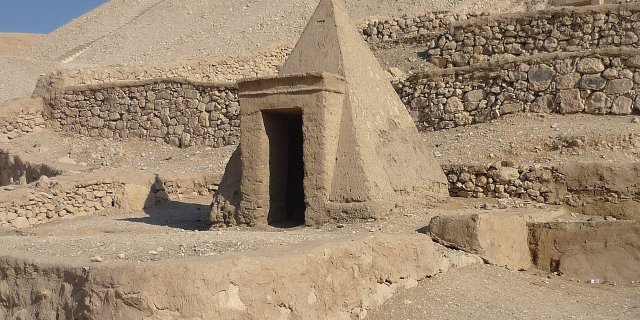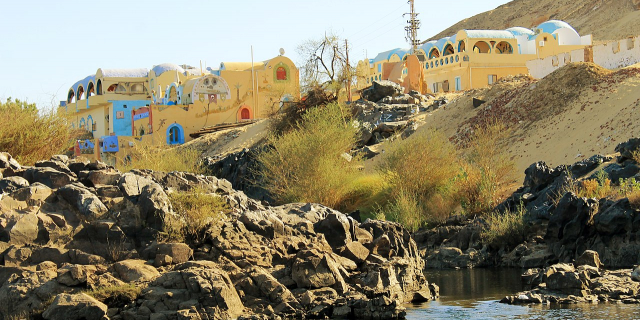وادي الملوك
( Valley of the Kings )
The Valley of the Kings (Egyptian Arabic: وادى الملوك Wādī el-Mulūk; Coptic: ϫⲏⲙⲉ Džēme [ˈʃɪ.mæ]), also known as the Valley of the Gates of the Kings (وادى ابواب الملوك Wādī Ebwāb el-Mulūk), is an area in Egypt where, for a period of nearly 500 years from the Eighteenth Dynasty to the Twentieth Dynasty, rock-cut tombs were excavated for pharaohs and powerful nobles under the New Kingdom of ancient Egypt.
It is a wadi sitting on the west bank of the Nile, opposite Thebes (modern-day Luxor) and within the heart of the Theban Ne...Read more
The Valley of the Kings (Egyptian Arabic: وادى الملوك Wādī el-Mulūk; Coptic: ϫⲏⲙⲉ Džēme [ˈʃɪ.mæ]), also known as the Valley of the Gates of the Kings (وادى ابواب الملوك Wādī Ebwāb el-Mulūk), is an area in Egypt where, for a period of nearly 500 years from the Eighteenth Dynasty to the Twentieth Dynasty, rock-cut tombs were excavated for pharaohs and powerful nobles under the New Kingdom of ancient Egypt.
It is a wadi sitting on the west bank of the Nile, opposite Thebes (modern-day Luxor) and within the heart of the Theban Necropolis. There are two main sections: the East Valley, where the majority of the royal tombs are situated; and the West Valley, otherwise known as the Valley of the Monkeys.
With the 2005 discovery of a new chamber and the 2008 discovery of two further tomb entrances, the Valley of the Kings is known to contain 65 tombs and chambers, ranging in size from the simple pit that is KV54 to the complex tomb that is KV5, which alone has over 120 chambers for the sons of Ramesses II. It was the principal burial place for the New Kingdom's major royal figures as well as a number of privileged nobles. The royal tombs are decorated with traditional scenes from Egyptian mythology and reveal clues to the period's funerary practices and afterlife beliefs. Almost all of the tombs seem to have been opened and robbed in antiquity, but they still give an idea of the opulence and power of Egypt's pharaohs.
This area has been a focus for Egyptologists and archaeological exploration since the end of the 18th century, and its tombs and burials continue to stimulate research and interest. The Valley of the Kings garnered significant attention following the discovery of the tomb of Tutankhamun in 1922, and is one of the most famous archaeological sites in the world. In 1979, it became a UNESCO World Heritage Site alongside the rest of the Theban Necropolis. Exploration, excavation, and conservation continues in the area and a new tourist centre has recently been opened.
 The "Sepulchres of the Kings of Thebes", Richard Pococke, 1743
The "Sepulchres of the Kings of Thebes", Richard Pococke, 1743 Al-Qurn dominates the valley.
Al-Qurn dominates the valley.The Theban Hills are dominated by the peak of al-Qurn, known to the Ancient Egyptians as ta dehent, or "The Peak".[1] It has a pyramid-shaped appearance, and it is probable that this echoed the pyramids of the Old Kingdom, more than a thousand years prior to the first royal burials carved here.[2][3] Its isolated position also resulted in reduced access, and special tomb police (the Medjay) were able to guard the necropolis.[4]
While the iconic pyramid complex of the Giza Plateau have come to symbolize ancient Egypt, the majority of tombs were cut into rock. Most pyramids and mastabas contain sections which were cut into ground level, and there are full rock-cut tombs in Egypt that date back to the Old Kingdom.[5]
After the defeat of the Hyksos and the reunification of Egypt under Ahmose I, the Theban rulers began to construct elaborate tombs that reflected their newfound power.[6] The tombs of Ahmose I and his son Amenhotep I (their exact location remains unknown) were probably in the Seventeenth Dynasty necropolis of Dra' Abu el-Naga'.[7] The first royal tombs in the Valley of the Kings were those of Amenhotep I (although this identification is also disputed),[8] and Thutmose I, whose advisor, Ineni, notes in his tomb that he advised the king to place his tomb in the desolate valley (the identity of this actual tomb is unclear, but it is probably KV20 or KV38).[1]
I saw to the excavation of the rock-tomb of his majesty, alone, no one seeing, no one hearing.[9]
The Valley was used for primary burials from approximately 1539 BC to 1075 BC. It contains at least 63 tombs, beginning with Thutmose I (or possibly earlier, during the reign of Amenhotep I) and ending with Ramesses X or XI, although non-royal burials continued in usurped tombs.[10]
Despite its name, the Valley of the Kings also contains the tombs of favorite nobles as well as the wives and children of both nobles and pharaohs. Therefore, only about twenty of the tombs actually contain the remains of kings. The remains of nobles and of the royal family, together with unmarked pits and embalming caches, make up the rest.[11] Around the time of Ramesses I (ca. 1301 BC) construction commenced in the separate Valley of the Queens.[12]
Royal NecropolisThe official name for the site in ancient times was The Great and Majestic Necropolis of the Millions of Years of the Pharaoh, Life, Strength, Health in The West of Thebes (see below for the hieroglyphic spelling), or Ta-sekhet-ma'at (the Great Field).[13]
At the start of the Eighteenth Dynasty, only kings were buried within the valley in large tombs. When a non-royal person was buried, it was in a small rock cut chamber, close to the tomb of their master.[9] Amenhotep III's tomb was constructed in the Western Valley, and while his son Akhenaten moved his tomb's construction to Amarna, it is thought that the unfinished WV25 may have originally been intended for him.[14] With the return to religious orthodoxy at the end of the Eighteenth Dynasty, Tutankhamun, Ay, and Horemheb returned to the royal necropolis.[15]
The Nineteenth and Twentieth Dynasties saw an increase in the number of burials (both here and in the Valley of the Queens), with Ramesses II and later Ramesses III each constructing a massive tomb used for the burial of their sons (KV5 and KV3 respectively).[16][17] There are some kings that are not buried within the valley or whose tomb has not been located: Thutmose II may have been buried in Dra' Abu el-Naga' (although his mummy was in the Deir el-Bahari tomb cache),[18] Smenkhkare's burial has never been located, and Ramesses VIII seems to have been buried elsewhere.
In the Pyramid Age, the pyramid tomb of a king was associated with a mortuary temple located close to the pyramid. Since the tombs of the kings in the Valley of the Kings were hidden, the kings' mortuary temples were located away from their burial sites, closer to the cultivation facing Thebes.[1] These mortuary temples became places visited during the various festivals held in the Theban necropolis. Most notable is the Beautiful festival of the valley, where the sacred barques of Amun-Re, his consort, Mut, and son, Khonsu, left the temple at Karnak in order to visit the funerary temples of deceased kings on the West Bank and their shrines in the Theban Necropolis.[19]
The tombs were constructed and decorated by the workers of the village of Deir el-Medina, located in a small wadi between this valley and the Valley of the Queens, facing Thebes. The workers journeyed to the tombs through various routes over the Theban hills. The daily lives of these workers are quite well known due to their being recorded in tombs and official documents.[20] Amongst the events documented is perhaps the first recorded workers' strike, detailed in the Turin Strike Papyrus.[21][22][23]

























Add new comment